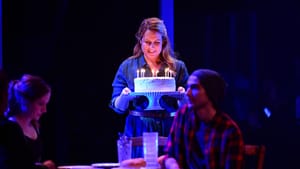Stay in the Loop
BSR publishes on a weekly schedule, with an email newsletter every Wednesday and Thursday morning. There’s no paywall, and subscribing is always free.
A new normal
Media Theatre presents Tom Kitt and Brian Yorkey's 'Next to Normal'

Even among this generation's small-cast musicals, 2008's Next to Normal, currently in production at Media Theatre, is a fascinating anomaly. Six actors — including one who plays two roles — keep composer Tom Kitt and playwright-lyricist Brian Yorkey's Pulitzer-winning rock musical intimate. More striking, though, is Next to Normal's subject: a suburban housewife's mental illness.
This isn't a musical with cheery anthems, rousing chorus numbers, or explosive dances. It nevertheless succeeds, as Media's well-cast revival, directed by Geoffrey Goldberg, shows. It's better described as a play with mostly sung dialogue and near-constant live underscoring by music director Ben Kapilow's capable six-musician band.
This means Next to Normal's storytelling feels like a play, while allowing emotional and mental depth to bubble to the surface in song. It resembles what all musicals do but remains more grounded in realism; songs emerge naturally from discussions around a kitchen table.
Genuine unhappiness
Krissy Fraelich plays Diana, a seemingly normal wife and mom struggling with ongoing depression. Her condition wears down husband Dan (Ben Dibble) and daughter Natalie (Molly Sorensen). Diana sees a "psychopharmacologist" whose array of pills leaves her listless.
She dumps the pharmaceuticals to try psychotherapy, including hypnosis and electroconvulsive therapy (ECT). Her harrowing mental and emotional turmoil feels realistic even while the entire role is sung. However, unlike clinical sufferers, Diana's depression is situational, which means it was triggered by a specific event.
Next to Normal convincingly reveals the effects of her illness on Dan and Natalie. Sorensen, a high-school junior, is particularly moving as Natalie, whose achievements mask a desperate and unsuccessful cry for attention from her parents. She finds some comfort with boyfriend Henry (Christopher Infantino) but is ashamed of her family's troubles.
I don't think anyone's ever seen a less-than-stunning Dibble performance, but he's particularly genuine here as a befuddled average guy who wants a normal life. As always, he’s also in fine voice.
Patrick Ludt plays Diana's two doctors, and Ronnie Keller excels in an enigmatic role based on Diana's fantasies.
Kyle Brylczyk's set suggests a suburban home whose platforms and stairways also clarify Diana's fractured consciousness. Steven Spera's lighting feels dark because the show focuses so much on individuals, and the lighting must comply — but he saves some striking surprises for the finale.
Lexa Grace's costumes grimly emphasize Diana's upheaval and the family's emotional state. When Natalie reveals a bright blue dress for her first dance, it's a shock of normal life.
Don't expect answers from musicals
Next to Normal is emotionally raw and offers few real solutions, but this approach feels more honest than manufacturing a happy ending. The production stresses hope in its final number, "Let There Be Light," but to express it the characters literally step out of the action, facing us in a line downstage. The truth I mulled afterward is that action — any sort of positive attempt at recovery — provides opportunity and hope.
Some characters learn they can't help others and shouldn't condemn themselves for it; others learn that they can help and should risk rejection to try. Hopefully, we're all a bit more aware after Next to Normal that "normal" is an elusive, perhaps impossible, ideal.
What, When, Where
Next to Normal. Music by Tom Kitt, book and lyrics by Brian Yorkey, Gregory Goldberg directed. Through February 25, 2018, at the Media Theatre, 104 East State Street, Media, Pennsylvania. (610) 891-0100 or mediatheatre.org.
Sign up for our newsletter
All of the week's new articles, all in one place. Sign up for the free weekly BSR newsletters, and don't miss a conversation.
 Mark Cofta
Mark Cofta